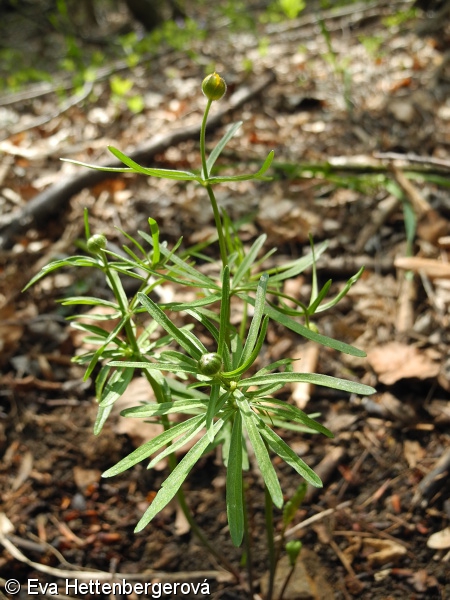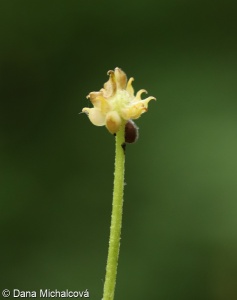Ranunculus auricomus aggr.
Data
download factsheetHabitus and growth type
-
Plant height [m]: 0.39?
-
Life span: Perennial?
-
Life form: Hemicryptophyte?
Flower
-
Flowering period: March-August?
Fruit, seed and dispersal
-
Dispersal mode: Local non-specific dispersal?
-
Dispersal distance class: 2?
Trophic mode
-
Parasitism and mycoheterotrophy: autotroph?
-
Carnivory: non-carnivorous?
-
Symbiotic nitrogen fixation: no nitrogen-fixing symbionts?
Taxon origin
-
Origin in Europe: Native?
Ecology
-
Environmental relationships
-
Substrate humidity relationship: Wet?
-
Substrate reaction relationship: Alkaline?
-
Nutrient relationship: Eutrophic?
-
Salinity relationship: Non-saline?
-
Ellenberg-type indicator values
-
Moisture indicator value: 6.6?
-
Reaction indicator value: 7?
-
Nutrient indicator value: 6.2?
-
Salinity indicator value: 0?
-
Disturbance indicator values
-
Disturbance frequency: 0.37?
-
Disturbance frequency (herb layer): 1.55?
-
Disturbance severity: 0.6?
-
Disturbance severity (herb layer): 0.35?
-
Mowing frequency: 0.31?
-
Grazing pressure: 0.18?
-
Soil disturbance: 0.16?
Habitat and sociology
-
EUNIS habitat
-
Diagnostic species of EUNIS habitats: R35 Moist or wet mesotrophic to eutrophic hay meadow, T1E Carpinus and Quercus mesic deciduous forest?
-
Constant species of EUNIS habitats: R35 Moist or wet mesotrophic to eutrophic hay meadow, T1E Carpinus and Quercus mesic deciduous forest?
-
Broad habitat
-
Occurrence in broad habitats: Aquatic, Spring, Wetland, Grassland (non-alpine, non-saline), Scrub, Forest, Sparsely vegetated (incl. rock and scree)?
Distribution
-
Country-based map: Not available
Subordinate taxa
number of results: 813
Ranunculus abbaianus
Ranunculus abditus
Ranunculus abortificus
Ranunculus abstrusus
Ranunculus acarpellophorus
Ranunculus accedens
Ranunculus acidotus
Ranunculus acinaciformis
Ranunculus acrifoliiformis
Ranunculus acrifolius
Ranunculus acuistylus
Ranunculus acutidens
Ranunculus acutidentiformis
Ranunculus acutimammus
Ranunculus acutipartitus
Ranunculus acutiserratus
Ranunculus acutiusculus
Ranunculus adunans
Ranunculus aemulans
Ranunculus aequalis
Ranunculus aequidens
Ranunculus afzelii
Ranunculus agynophorus
Ranunculus albertsonii
Ranunculus alcicornis
Ranunculus allemannii
Ranunculus almquistii
Ranunculus alnetorum
Ranunculus alsaticus
Ranunculus alsophilus
Ranunculus alticaulis
Ranunculus altilobus
Ranunculus altior
Ranunculus altitorus
Ranunculus amabilis
Ranunculus amaurophanes
Ranunculus amblyodon
Ranunculus ambranus
Ranunculus ameres
Ranunculus amoeniflorus
Ranunculus amoenifrons
Ranunculus amoenoviridis
Ranunculus amplidens
Ranunculus amplisinus
Ranunculus anandrophyllus
Ranunculus anandrus
Ranunculus ancorifolius
Ranunculus anemonophyllus
Ranunculus angustatus
Ranunculus angustidens
Ranunculus angustifidus
Ranunculus angustilobulus
Ranunculus angustior
Ranunculus angustitorus
Ranunculus angustus
Ranunculus anisodon
Ranunculus anisophyllus
Ranunculus antygodon
Ranunculus antygophyllus
Ranunculus apertiformis
Ranunculus apertisinus
Ranunculus apertus
Ranunculus apheles
Ranunculus apiculatus
Ranunculus appropinquans
Ranunculus arctophilus
Ranunculus arcuiformans
Ranunculus argoviensis
Ranunculus archangelicus
Ranunculus ariodon
Ranunculus arvidii
Ranunculus arwidsonii
Ranunculus asplundii
Ranunculus asterodes
Ranunculus asymmetrus
Ranunculus atriviolascens
Ranunculus atrovirens
Ranunculus attenuans
Ranunculus attingens
Ranunculus auricomiformis
Ranunculus aurosulus
Ranunculus austrokarelicus
Ranunculus baeckii
Ranunculus baguetii
Ranunculus balatonensis
Ranunculus baldensis
Ranunculus bariscianus
Ranunculus basitruncatus
Ranunculus bathyodon
Ranunculus bayerae
Ranunculus bekesensis
Ranunculus bellicrenatus
Ranunculus belliflorus
Ranunculus bellulus
Ranunculus beregensis
Ranunculus bergeri
Ranunculus bernatskyanus
Ranunculus biclaterae
Ranunculus bicolor
Ranunculus biformis
Ranunculus binatus
Ranunculus blandus
Ranunculus boldtii
Ranunculus borbasianus
Ranunculus boreigenus
Ranunculus boreoapenninus
Ranunculus borchers-kolbiae
Ranunculus bottnicus
Ranunculus bovii
Ranunculus brabantianus
Ranunculus brachygynophorus
Ranunculus brachyphyllarius
Ranunculus brachyschides
Ranunculus braun-blanquetii
Ranunculus brevidens
Ranunculus brevifidus
Ranunculus brevistylus
Ranunculus brunnescens
Ranunculus brunnescentoides
Ranunculus budaianus
Ranunculus budensis
Ranunculus buekkensis
Ranunculus caespitosulus
Ranunculus cajanderi
Ranunculus caliginosus
Ranunculus callimorphoides
Ranunculus callimorphus
Ranunculus calliodon
Ranunculus caloschistus
Ranunculus calvescens
Ranunculus campanulatus
Ranunculus canaster
Ranunculus canastriformis
Ranunculus cancrifolius
Ranunculus carlittensis
Ranunculus carnosulus
Ranunculus caroli-frederici
Ranunculus carpinetorum
Ranunculus cassubiciformis
Ranunculus cedercreutzii
Ranunculus cinereoviridis
Ranunculus circinans
Ranunculus circinatifrons
Ranunculus clariflorus
Ranunculus clavulifer
Ranunculus cochlearifer
Ranunculus coleophorus
Ranunculus collanderi
Ranunculus commemorans
Ranunculus compar
Ranunculus compluridens
Ranunculus concavus
Ranunculus concinnifolius
Ranunculus concinnifrons
Ranunculus concordans
Ranunculus concretus
Ranunculus confinis
Ranunculus coniformis
Ranunculus conjungens
Ranunculus connectens
Ranunculus consectus
Ranunculus constans
Ranunculus contegens
Ranunculus corylisinus
Ranunculus cosmophyllus
Ranunculus crassicaulis
Ranunculus crassitruncus
Ranunculus crassiusculus
Ranunculus crassus
Ranunculus crebridens
Ranunculus crenatolobus
Ranunculus crenifer
Ranunculus crenifolius
Ranunculus cuneaticans
Ranunculus curvatus
Ranunculus curvicaulis
Ranunculus dactylophylloides
Ranunculus dactylophyllus
Ranunculus danubius
Ranunculus decorifactus
Ranunculus decorus
Ranunculus decrescens
Ranunculus defectiflorus
Ranunculus defectus
Ranunculus deformis
Ranunculus deleniens
Ranunculus delvosallei
Ranunculus demarsinii
Ranunculus deminuens
Ranunculus deripovae
Ranunculus dialeptus
Ranunculus digitatifolius
Ranunculus dimidiatus
Ranunculus diodon
Ranunculus dispar
Ranunculus dissidens
Ranunculus dissimilifolius
Ranunculus distendens
Ranunculus djuloeensis
Ranunculus doerrii
Ranunculus duciformis
Ranunculus ducis
Ranunculus dysandrus
Ranunculus dysanthus
Ranunculus effingens
Ranunculus egens
Ranunculus elatior
Ranunculus elegantifrons
Ranunculus elisae
Ranunculus ellipes
Ranunculus emersus
Ranunculus emmetrus
Ranunculus engelianus
Ranunculus envalirensis
Ranunculus epacrus
Ranunculus erectidens
Ranunculus erectus
Ranunculus erythrogonius
Ranunculus euanthemus
Ranunculus eugyalus
Ranunculus eumorphus
Ranunculus euprepes
Ranunculus euryanthes
Ranunculus eurycolpus
Ranunculus euryphyllarius
Ranunculus euthygrammus
Ranunculus eversii
Ranunculus evolutus
Ranunculus excellentis
Ranunculus excisus
Ranunculus exiguidens
Ranunculus exiguifrons
Ranunculus expansus
Ranunculus fagerstroemii
Ranunculus fallacifolius
Ranunculus fallacillus
Ranunculus fallax
Ranunculus farraensis
Ranunculus feripes
Ranunculus ferocior
Ranunculus festivus
Ranunculus fiorii
Ranunculus firmicaulis
Ranunculus firmulus
Ranunculus fissifolius
Ranunculus flabellifolius
Ranunculus flabelliformis
Ranunculus forstfeldensis
Ranunculus fraelensis
Ranunculus fragifer
Ranunculus fragilis
Ranunculus furvellus
Ranunculus fuscinus
Ranunculus fuscus
Ranunculus galbanus
Ranunculus ganeschinii
Ranunculus gayeri
Ranunculus geissertii
Ranunculus geminatus
Ranunculus glabritorus
Ranunculus glaphyranthus
Ranunculus glaucescens
Ranunculus glaucus
Ranunculus glechomoides
Ranunculus globosus
Ranunculus glossophorus
Ranunculus golitzynii
Ranunculus gonophyllus
Ranunculus gortanii
Ranunculus gracilicaulis
Ranunculus gracilifolius
Ranunculus gracilior
Ranunculus gracillimus
Ranunculus graecensis
Ranunculus grandilobatus
Ranunculus gratiosus
Ranunculus gregalis
Ranunculus gripsholmiensis
Ranunculus grossidens
Ranunculus guelzowiensis
Ranunculus gyratidens
Ranunculus gyratifrons
Ranunculus haasii
Ranunculus haesselbyholmiensis
Ranunculus hannae
Ranunculus hannonianus
Ranunculus heikkinenii
Ranunculus helveticus
Ranunculus hemicyclodes
Ranunculus hemicyclodon
Ranunculus hemicyclophyllus
Ranunculus heuffelii
Ranunculus hevellus
Ranunculus hicanostylus
Ranunculus hilarans
Ranunculus hirsutulus
Ranunculus holanthus
Ranunculus hortensis
Ranunculus hortobagyianus
Ranunculus hortorum
Ranunculus hostiliensis
Ranunculus hungaricus
Ranunculus hypochromatinus
Ranunculus hypselus
Ranunculus chasii
Ranunculus chlorellus
Ranunculus chopericus
Ranunculus chrysoleptos
Ranunculus idiophylloides
Ranunculus idiophyllus
Ranunculus illudens
Ranunculus imitans
Ranunculus imitator
Ranunculus imparidens
Ranunculus inaequalidens
Ranunculus inaequalis
Ranunculus inaptus
Ranunculus incisulus
Ranunculus incisurifer
Ranunculus inclinatus
Ranunculus incompletus
Ranunculus inconcinnus
Ranunculus inconspectiflorus
Ranunculus inconspectiformis
Ranunculus inconspectus
Ranunculus indecorus
Ranunculus inextricabilis
Ranunculus infuscus
Ranunculus inchoatus
Ranunculus inopinus
Ranunculus integerrimus
Ranunculus intervallatus
Ranunculus intervallicarens
Ranunculus intricatifrons
Ranunculus irregularis
Ranunculus islandicus
Ranunculus isophylloides
Ranunculus isophyllus
Ranunculus istriacus
Ranunculus janischevskyi
Ranunculus javorkae
Ranunculus jucundus
Ranunculus julinii
Ranunculus juratensis
Ranunculus kajanensis
Ranunculus kalinensis
Ranunculus karelicus
Ranunculus karpatianus
Ranunculus kemensis
Ranunculus kitinensis
Ranunculus kittilensis
Ranunculus klingstedtii
Ranunculus krylovii
Ranunculus kujalae
Ranunculus kunzii
Ranunculus kvedbyensis
Ranunculus kvistii
Ranunculus kymmenensis
Ranunculus kyyhkynenii
Ranunculus lacer
Ranunculus lacerescens
Ranunculus lacinulatus
Ranunculus laestadii
Ranunculus laetevirens
Ranunculus laeticolor
Ranunculus laetifrons
Ranunculus landsorticola
Ranunculus latiangulus
Ranunculus latiapex
Ranunculus laticrenatus
Ranunculus latidens
Ranunculus latifolius
Ranunculus latifrons
Ranunculus latiphyllarius
Ranunculus latisectus
Ranunculus latisinuatus
Ranunculus latisinus
Ranunculus lawalreei
Ranunculus lecithodes
Ranunculus lepidulus
Ranunculus lepidus
Ranunculus leptomeris
Ranunculus leptophyes
Ranunculus leptophyllarius
Ranunculus leptostylus
Ranunculus leslieanus
Ranunculus linearifidus
Ranunculus linearis
Ranunculus lingulatus
Ranunculus linkolae
Ranunculus litoricola
Ranunculus longidens
Ranunculus longimammiformis
Ranunculus longimammus
Ranunculus longipilosus
Ranunculus longistylus
Ranunculus lonchophyllarius
Ranunculus lucescens
Ranunculus lucorum
Ranunculus luminarius
Ranunculus lunaris
Ranunculus lundbyensis
Ranunculus lundevallii
Ranunculus luxuriosus
Ranunculus lyngei
Ranunculus lyratus
Ranunculus macilentus
Ranunculus macrantherus
Ranunculus macrocarpellophorus
Ranunculus macrodactylus
Ranunculus macrophyllarius
Ranunculus macrotis
Ranunculus maelarensis
Ranunculus maelbyensis
Ranunculus magnidens
Ranunculus magnifolius
Ranunculus magnimammus
Ranunculus magnitorifer
Ranunculus mammiformidens
Ranunculus mancus
Ranunculus manifestus
Ranunculus marginicola
Ranunculus marklundii
Ranunculus marmarosensis
Ranunculus matrensis
Ranunculus maurochlorus
Ranunculus mediocrifidus
Ranunculus mediocris
Ranunculus mediogracilis
Ranunculus mediosectus
Ranunculus medioximus
Ranunculus megacarpus
Ranunculus megalocaulis
Ranunculus megalodon
Ranunculus megalodontoides
Ranunculus meionophyllus
Ranunculus melzeri
Ranunculus membranaster
Ranunculus mendax
Ranunculus mendosus
Ranunculus mergenthaleri
Ranunculus mesidius
Ranunculus metabolus
Ranunculus metrius
Ranunculus micrasterias
Ranunculus microdon
Ranunculus mimulus
Ranunculus minutifrons
Ranunculus minutulus
Ranunculus modestifrons
Ranunculus modestipilosus
Ranunculus moerkoeensis
Ranunculus moeszii
Ranunculus monacensis
Ranunculus monopetalus
Ranunculus monophyllus
Ranunculus montellii
Ranunculus monticola
Ranunculus montserratii
Ranunculus moorii
Ranunculus mosanus
Ranunculus mosbachensis
Ranunculus mosellanus
Ranunculus multipartitus
Ranunculus multisectus
Ranunculus multistamineus
Ranunculus multistaminifer
Ranunculus mutinensis
Ranunculus nannfeldtii
Ranunculus nemoricola
Ranunculus nemorosifolius
Ranunculus neoascendens
Ranunculus nephrodes
Ranunculus nephromorphus
Ranunculus nephrophyllus
Ranunculus neumanii
Ranunculus nicklesii
Ranunculus niepolomicensis
Ranunculus nigellus
Ranunculus nontunensis
Ranunculus noricus
Ranunculus nothus
Ranunculus obliquifolius
Ranunculus oblongus
Ranunculus obovatus
Ranunculus obscurans
Ranunculus obscuraster
Ranunculus obscurisepalus
Ranunculus obscuroviridis
Ranunculus obtruncatus
Ranunculus obtusidens
Ranunculus obtusidentatus
Ranunculus obtusidentiformis
Ranunculus obtusulus
Ranunculus oculatidens
Ranunculus oinonenii
Ranunculus olgae
Ranunculus oligandroides
Ranunculus oligandromorphus
Ranunculus oligandrus
Ranunculus oligodon
Ranunculus olofssonii
Ranunculus ophiocladus
Ranunculus opimus
Ranunculus orbicans
Ranunculus orbifolius
Ranunculus ornatus
Ranunculus orphnodes
Ranunculus orthocladus
Ranunculus ostrobottnicus
Ranunculus ovatitoratus
Ranunculus ovessnovii
Ranunculus oxymorphus
Ranunculus oxyodon
Ranunculus pachyphyton
Ranunculus palaeoeuganeus
Ranunculus palmgrenii
Ranunculus palmularis
Ranunculus paludum
Ranunculus pankakoskii
Ranunculus pannonicus
Ranunculus papilionaceus
Ranunculus paralbertsonii
Ranunculus parallelus
Ranunculus paranephrophyllus
Ranunculus parcipilosus
Ranunculus parcisectus
Ranunculus parobscurans
Ranunculus paroicus
Ranunculus parviflorifer
Ranunculus parvirostratus
Ranunculus parvitorifer
Ranunculus parvitorus
Ranunculus parvulifactus
Ranunculus parvulifrons
Ranunculus pastorum
Ranunculus patens
Ranunculus patulidens
Ranunculus patulidentiformis
Ranunculus pawlowskii
Ranunculus pectinifolius
Ranunculus pedemontanus
Ranunculus pedrottii
Ranunculus pendulus
Ranunculus pentadactylus
Ranunculus pentameres
Ranunculus pentodon
Ranunculus percrassus
Ranunculus perelegans
Ranunculus perfectiflorus
Ranunculus pergamentaceus
Ranunculus pergracilis
Ranunculus petiolosus
Ranunculus petiolulatus
Ranunculus petroczenkoi
Ranunculus phaulanthus
Ranunculus philopadus
Ranunculus phragmiteti
Ranunculus pilicauliformis
Ranunculus pilicaulis
Ranunculus piliger
Ranunculus pilipes
Ranunculus pilisiensis
Ranunculus pilosifrons
Ranunculus pilulatus
Ranunculus pindicola
Ranunculus pinguescens
Ranunculus pinguifolius
Ranunculus platybasis
Ranunculus platycolpoides
Ranunculus platycolpus
Ranunculus platyloboides
Ranunculus platylobus
Ranunculus platyodon
Ranunculus plavensis
Ranunculus pleiophyllus
Ranunculus plesiolobus
Ranunculus poldinii
Ranunculus polyandrus
Ranunculus polyanthus
Ranunculus polycarpus
Ranunculus polydactyloides
Ranunculus polydactylus
Ranunculus polymeres
Ranunculus polyschistoides
Ranunculus polyschistus
Ranunculus ponojensis
Ranunculus porraceus
Ranunculus porrectidens
Ranunculus porrectifidus
Ranunculus porrectilobus
Ranunculus pospichalii
Ranunculus praecellens
Ranunculus praetermissus
Ranunculus prasinaster
Ranunculus prasinulus
Ranunculus preptanthus
Ranunculus prionodes
Ranunculus probiflorus
Ranunculus procurrens
Ranunculus procurrentiformis
Ranunculus prolixidens
Ranunculus prolixifidus
Ranunculus prolixitorus
Ranunculus pronicus
Ranunculus propinquilobus
Ranunculus prorsidens
Ranunculus prosotatus
Ranunculus prosseri
Ranunculus protendens
Ranunculus psepharus
Ranunculus pseudacutiusculus
Ranunculus pseudalsaticus
Ranunculus pseudoacris
Ranunculus pseudoaemulans
Ranunculus pseudobinatus
Ranunculus pseudobscurans
Ranunculus pseudocassubicus
Ranunculus pseudoincisifolius
Ranunculus pseudopimus
Ranunculus pseudosilvicola
Ranunculus pseudovertumnalis
Ranunculus psiloticus
Ranunculus puberulus
Ranunculus pulcher
Ranunculus pulchridentatus
Ranunculus pulchrifrons
Ranunculus pullaster
Ranunculus pullus
Ranunculus puringii
Ranunculus pusillicans
Ranunculus pusillidens
Ranunculus pycnodon
Ranunculus quadrivaginatus
Ranunculus quinatus
Ranunculus quinquangularis
Ranunculus rantae
Ranunculus rapaicsianus
Ranunculus rectiangulus
Ranunculus recticaulis
Ranunculus rectistylus
Ranunculus recurvens
Ranunculus regularis
Ranunculus reichenbachii
Ranunculus reichertii
Ranunculus remotilobus
Ranunculus reniger
Ranunculus resvoll-holmseniae
Ranunculus retroflexus
Ranunculus retusatus
Ranunculus retusidens
Ranunculus retusifolius
Ranunculus retusiformis
Ranunculus retusus
Ranunculus rheithroplesius
Ranunculus rhombilobus
Ranunculus rigidifolius
Ranunculus roborascens
Ranunculus robusticaulis
Ranunculus robustifolius
Ranunculus robustifrons
Ranunculus roessleri
Ranunculus rostratulus
Ranunculus rotarius
Ranunculus rotundatus
Ranunculus rotundellus
Ranunculus rotundidens
Ranunculus rubellinodes
Ranunculus rubellus
Ranunculus rubicundulus
Ranunculus rubrosepalus
Ranunculus rubroviolaceus
Ranunculus saelanii
Ranunculus sandemarensis
Ranunculus saturicolor
Ranunculus savonicus
Ranunculus scalaridens
Ranunculus scaldianus
Ranunculus scotinus
Ranunculus semicassubicus
Ranunculus semiorbicularis
Ranunculus septempartitus
Ranunculus serratifrons
Ranunculus serratus
Ranunculus schilleri
Ranunculus schurianus
Ranunculus sidereus
Ranunculus silanus
Ranunculus silvestris
Ranunculus silvicola
Ranunculus simplicior
Ranunculus singularis
Ranunculus sjoersii
Ranunculus slovacus
Ranunculus snaeckstavikensis
Ranunculus sonckii
Ranunculus spado
Ranunculus sparsipubescens
Ranunculus spectabilis
Ranunculus sphinx
Ranunculus spissidens
Ranunculus spissus
Ranunculus spryginii
Ranunculus stabilis
Ranunculus staubii
Ranunculus stellaris
Ranunculus stenocolpus
Ranunculus stenodes
Ranunculus stenodon
Ranunculus stenoschistus
Ranunculus stricticaulis
Ranunculus strongylus
Ranunculus styriacus
Ranunculus subbrevis
Ranunculus subcarpaticus
Ranunculus subconjungens
Ranunculus subcrassus
Ranunculus subdecumbens
Ranunculus subfirmicaulis
Ranunculus subfuscus
Ranunculus subglaber
Ranunculus subglaucescens
Ranunculus subglechomoides
Ranunculus subindivisus
Ranunculus subinermis
Ranunculus sublaetevirens
Ranunculus sublinearis
Ranunculus sublongimammus
Ranunculus subnemoricola
Ranunculus subobtusulus
Ranunculus suborbicularis
Ranunculus subpannonicus
Ranunculus subrobustus
Ranunculus subtatricus
Ranunculus subtectus
Ranunculus subtruncatus
Ranunculus subvastisectus
Ranunculus sudermannicus
Ranunculus sundinii
Ranunculus supernumerarius
Ranunculus supramedialis
Ranunculus suprasilvaticus
Ranunculus svirensis
Ranunculus sychnodon
Ranunculus sychnoschistus
Ranunculus symmetrus
Ranunculus szaferi
Ranunculus tabescens
Ranunculus tenebricans
Ranunculus tenebricaster
Ranunculus tenebrosus
Ranunculus tenerescens
Ranunculus teneriusculus
Ranunculus tenuisectus
Ranunculus tenuistylus
Ranunculus tersiflorus
Ranunculus tinctapex
Ranunculus tinctigemmatus
Ranunculus tinctisepalus
Ranunculus tinctivaginatus
Ranunculus tornensis
Ranunculus transiens
Ranunculus transtibiscensis
Ranunculus transversalis
Ranunculus tranzschelii
Ranunculus trautmannii
Ranunculus tridentifer
Ranunculus trichopus
Ranunculus trilobulatus
Ranunculus trinus
Ranunculus triplex
Ranunculus trisulcus
Ranunculus trivialis
Ranunculus truniacus
Ranunculus tureholmiensis
Ranunculus tusbyensis
Ranunculus tutus
Ranunculus udicola
Ranunculus uplandicus
Ranunculus urbicola
Ranunculus urjalensis
Ranunculus ustulatus
Ranunculus uxoris
Ranunculus vaginifer
Ranunculus valdesii
Ranunculus validus
Ranunculus valtae
Ranunculus vanneromii
Ranunculus varangerensis
Ranunculus variabilis
Ranunculus variantifrons
Ranunculus varicus
Ranunculus vastifolius
Ranunculus vastisectus
Ranunculus venustus
Ranunculus vertumnaliformis
Ranunculus vertumnalis
Ranunculus vestergrenii
Ranunculus viadensis
Ranunculus viburgensis
Ranunculus vindobonensis
Ranunculus viriditorus
Ranunculus vitellinus
Ranunculus vjatkensis
Ranunculus vorkutensis
Ranunculus vuolijokiensis
Ranunculus vytegrensis
Ranunculus walo-kochii
Ranunculus wilanderi
Ranunculus wraberi
Ranunculus zaplatys
Ranunculus zinselianus
Ranunculus zmudae



